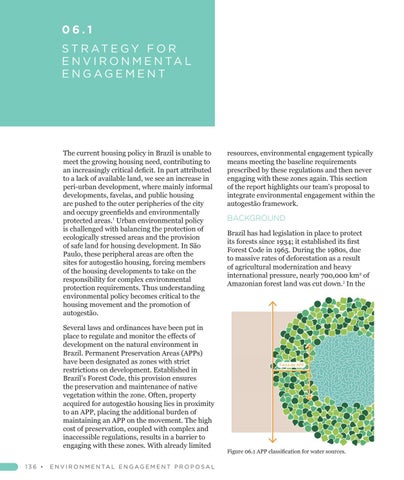06.1 S T R AT E G Y F O R E N V I R O N M E N TA L ENGAGEMENT
The current housing policy in Brazil is unable to meet the growing housing need, contributing to an increasingly critical deficit. In part attributed to a lack of available land, we see an increase in peri-urban development, where mainly informal developments, favelas, and public housing are pushed to the outer peripheries of the city and occupy greenfields and environmentally protected areas.1 Urban environmental policy is challenged with balancing the protection of ecologically stressed areas and the provision of safe land for housing development. In São Paulo, these peripheral areas are often the sites for autogestão housing, forcing members of the housing developments to take on the responsibility for complex environmental protection requirements. Thus understanding environmental policy becomes critical to the housing movement and the promotion of autogestão. Several laws and ordinances have been put in place to regulate and monitor the effects of development on the natural environment in Brazil. Permanent Preservation Areas (APPs) have been designated as zones with strict restrictions on development. Established in Brazil’s Forest Code, this provision ensures the preservation and maintenance of native vegetation within the zone. Often, property acquired for autogestão housing lies in proximity to an APP, placing the additional burden of maintaining an APP on the movement. The high cost of preservation, coupled with complex and inaccessible regulations, results in a barrier to engaging with these zones. With already limited 136 •
E N V I R O N M E N TA L E N G A G E M E N T P R O P O S A L
resources, environmental engagement typically means meeting the baseline requirements prescribed by these regulations and then never engaging with these zones again. This section of the report highlights our team’s proposal to integrate environmental engagement within the autogestão framework.
BACKGROUND Brazil has had legislation in place to protect its forests since 1934; it established its first Forest Code in 1965. During the 1980s, due to massive rates of deforestation as a result of agricultural modernization and heavy international pressure, nearly 700,000 km2 of Amazonian forest land was cut down.2 In the
Figure 06.1 APP classification for water sources.













